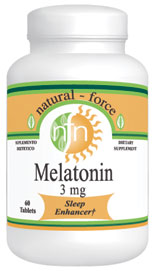
Benefits
- Melatonin can be used for jet lag.
- Melatonin can be used for symptoms similar to jet-lag, such as those that are the result of working a rotating shift.
- Melatonin can be used for seasonal affective disorder (SAD).
This article is bound to put you to sleep, or at least it will if you are taking Melatonin! A lot has been written and said about what Melatonin has been shown to do, and what it can actually do. The Melatonin blitz of the 90’s came and went for a number of reasons, some of the market slowdown was due to the poor quality of what was being sold at the time. Now the market is starting to come full circle, the quality of product being sold is far superior to what had been offered in the past. And the research on Melatonin’s capabilities has been substantiated with respect to its ability to assist persons with insomnia to fall a sleep and to assist those with jet lag to recover at a faster pace.
Melatonin is a natural hormone that your body produces in the pineal gland located in the brain. Through sight, and the amount of light we are exposed to (light – dark cycle), the pineal gland responds by starting to produce melatonin as it gets dark to allow you to begin to slow down, this makes the sleep state more inviting. As the production rate beings to increase your body temperature drops and sleep onset begins. As daybreak begins, and it becomes brighter out side you begin to wake and the production of melatonin decreases to a point where it is less detectable during the waking state.
Melatonin levels are at their highest levels during puberty and begin to decline after that, it is not clear if this is age related or a factor of lifestyle. The elderly in general produce the least amount of Melatonin, and usually respond well to Melatonin intervention if needed. It has been stated that Melatonin is as safe as water. But unfortunately there has been a lot of unsubstantiated information written about melatonin with regards to being an anti aging product, curing Aids and cancer. The most exciting legitimate research to date has been is its use as a sleep aid. It has been shown that Melatonin helps to bring the bodies Circadian rhythms back into alignment. The body’s Circadian rhythm is a pattern that is different for everyone, but is cyclical in everyone. The timing may be different from one person to the next but it all is rhythmic, the bodies system run in different pattern depending on that persons life circumstances. Melatonin helps to regulate these patterns, by keeping the internal clock running efficiently. There are a number of reasons the bodies clock can be thrown out of phase; some of them are stress, improper lifestyle, depression and substance abuse just to name a few.
Melatonin in the form currently being made available to the public can be used as a preventative, or a treatment for jet-lag, seasonal affective disorder (SAD), and certain types of depression. It is typically taken by people with sleep disorders approximately one half hour before going to bed. People with insomnia may wish to take melatonin 2-3 hours before the time they wish to fall asleep. For people wanting to fall asleep earlier than they currently do (including people trying to avoid jet-lag), a melatonin supplement should be taken 2-3 hours before their new desired time. The appropriate dosage can vary significantly from one person to another. For people under 40 without sleep disorders and for those who do not want to change their circadian rhythm, it is prudent to start with a small dose. People over 40 who wish to change their circadian rhythm may want to start with a slightly higher dose. If the person finds that he has slept well but is drowsy in the morning, then cut the dose in half. If the dose had little or no sleep-inducing effect, then the user may want to increase the dose until the desired effect is achieved.
Toxicity, Cautions & Contraindications:
In a supplement form, melatonin is considered to be non-toxic. However, melatonin supplements should not be taken by adolescents, pregnant or lactating women, people taking cortisone, or people with kidney disease. †
REFERENCES:
- Jean-Louis G, von Gizycki H, Zizi FP. redictors of subjective sleepiness induced by melatonin administration. J Psychosom Res 1999 Oct;47(4):355-8.
- Sack RL, Lewy AJ, Hughes RJ. Use of melatonin for sleep and circadian rhythm disorders. Ann Med 1998 Feb;30(1):115-21.
- Goldman BD. The circadian timing system and reproduction in mammals. Steroids 1999 Sep;64(9):679-85.
- Sakotnik A, Liebmann PM, Stoschitzky K, Lercher P, Schauenstein K, Klein W, Eber B. Decreased melatonin synthesis in patients with coronary artery disease. Eur Heart J 1999 Sep;20(18):1314-7.
- Shanahan TL, Kronauer RE, Duffy JF, Williams GH, Czeisler CA. Melatonin rhythm observed throughout a three-cycle bright-light stimulus designed to reset the human circadian pacemaker. J Biol Rhythms 1999 Jun;14(3):237-53.
Packaging: 3 mg., 60 tablets
Back to Top
†These statements have not been evaluated by the FDA. These products are not intended to diagnose, treat, cure or prevent any disease. |